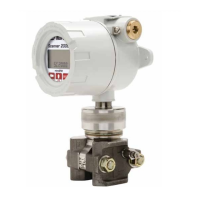42
Section 2 Scanner
®
2000 microEFM
Measuring Steam via a Differential Pressure Meter
Note This section contains installation guidelines for orice and cone meters. If installing the Scanner 2000
with an averaging pitot tube meter, refer to manufacturer instructions for installation.
Best Practices
The Scanner 2000 calculates steam ow in accordance with IF-97, AGA-3, and ISO-5167 industry standards.
For optimum performance, ensure that the installation complies with the following industry recommendations:
Condensate pots
• A condensate pot for a small-volume transducer like the Scanner 2000 MVT can be a simple pipe tee,
oriented so that one port extends downward (into the cold leg), the opposite port extends upward and is
closed by a pipe cap or blowdown valve, and the tee extends horizontally into the hot leg.
• The pots should be the highest point in the system.
• The pots should be mounted at the same level, and one or both should be adjustable vertically to remove
zero shifts in the differential pressure measurement.
Hot legs
• Hot legs should be large diameter (3/8 in. or 1/2 in., if possible)
• Hot legs should be as short as possible. If these sections must be more than 1 ft. in length, insulate them.
• Elbows and bends should not form any traps in which liquid can accumulate.
• Hot legs should be sloped along their entire length to allow liquids to drain back into the pipe.
Cold legs
• Cold legs should enter the multi-variable sensor through its side ports.
• Cold legs should be a minimum of 2 ft in length to allow proper convection cooling and should be run
horizontally with a slope of approximately 1 inch per foot to allow air bubbles to oat up into the pots.
• Elbows and bends should not form any traps for air bubbles.
• Cold legs should be lled with a suitable antifreeze. Dibutyl phthalate is recommended.
Antifreeze
• Dibutyl phthalate (DBP) has the following advantages over glycol antifreeze:
– DBP doesn’t mix with water, and so doesn’t become dilute over time; its specic gravity doesn’t shift.
– It is slightly denser than water, so it will stay in the pot permanently.
– It is non-ammable.
– It is much less toxic than glycol.
– It is available from industrial suppliers.
Valves
• Use only full-opening block valves that are rated for steam service.
• Use only blowdown valves that are rated for steam service. Periodic blowdowns are recommended for
preventing buildup of scale.

